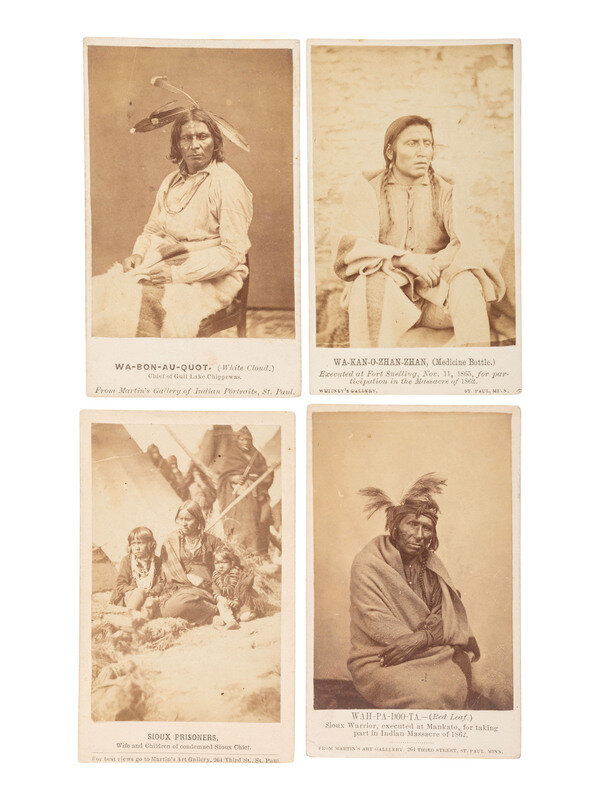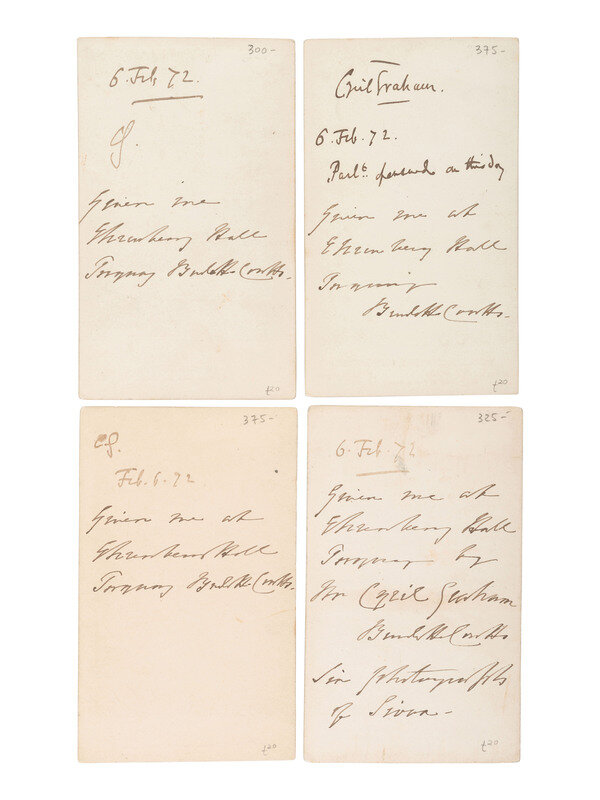Condition Report
Contact Information
Auction Specialist
Lot 228
Sale 6425 - American Historical Ephemera and Early Photography, including The Larry Ness Collection of Native American Photography
Part I - Lots 1-222
Oct 23, 2025
10:00AM ET
Part II - Lots 223-376
Oct 24, 2025
10:00AM ET
Live / Cincinnati
Own a similar item?
Estimate
$600 -
800
Price Realized
$660
Sold prices are inclusive of Buyer’s Premium
Lot Description
A group of 4 CDVs of Sioux related to the 1862 Dakota Uprising in Minnesota, incl. subjects held and executed at Fort Snelling.
4 CDVs on cardstock mounts credited to Whitney's Gallery (2) and Martin's Art Gallery (2), both in St. Paul, Minnesota. The subjects, identified on rectos, include:
Wah-pa-doo-ta, aka Red Leaf, Sioux. Executed at Mankato for taking part in Indian Massacre of 1862. -- Wa-bon-au-quot, aka White Cloud, Chief of Gull Lake Chippewas. -- Wa-kan-o-zhan-zhan, aka Medicine Bottle, Mdewakanton Dakota. Executed at Fort Snelling, Nov. 11, 1865, for participation in the Massacre of 1862. -- Sioux Prisoners. Wife and Children of condemned Sioux Chief [Little Crow].
Each carte with collector's ink inscription on verso: "6 Feb. 72. Given me at Ehrenberg Hall, Torquay. [Signed] Burdett-Coutts."
The richest English woman of the 19th century, after Queen Victoria, was Baroness Angela Georgina Burdett-Coutts (1814-1906). Heiress to her grandfather's vast banking fortune, she was a doyenne of British society and a confidant and correspondent of Charles Dickens, with whom she sponsored a school for former prostitutes in London. Courted by many of the aristocracy for her fortune, she denied all suitors and lived to the age of 92. Ms. Burdett-Coutts was a leader of social reform in Britain and an inspiration to other activists. She championed the socially disadvantaged around the world, and was a strong supporter of missionary efforts. Her resources were very carefully invested in building schools and churches in Europe, Africa, Australia and North America. Her home was in London, but during 1860-75, she maintained a manor called Ehrenberg Hall near the southern seacoast at Torquay, east of Plymouth. There, in February 1872, she was visited by Sir Cyril Graham who presented her with six CDV portraits of Minnesota Indians, several involved in the Dakota War of 1862. Four of those cards, inscribed and dated by Ms. Burdett-Coutts, are offered here. For a biography, see Healey 1978.
The new state of Minnesota was home to thousands of Native Americans in 1862, many of whom were disenchanted with the government's promise for annuities. In August of that year, a number of the Dakota were starving; on the 18th, Indians at the Lower Agency attacked the white settlers there. Over the next few weeks hundreds of whites were killed, until the uprising was finally put down by Federal troops under the command of Henry Sibley.
Thirty-eight Dakota prisoners of war were hanged at the same time on a massive scaffold in the largest public execution in US history, at Mankato, Minnesota, 26 December 1862. More than 300 Dakota participants in the uprising of August 1862, had been tried and condemned by military tribunals, but most were spared by order of President Lincoln. Nearly all of the Dakota people were deported to Dakota Territory, at Crow Creek Reservation on the Missouri River, where many died of starvation and disease during the following three years. In 1866, the survivors were moved downriver to Santee, Nebraska, where their descendants remain.
Provenance: Cowan's, Historic Americana, 6 December 2007, lots 7, 12, 13, 15.
The Larry Ness Collection of Native American Photography
This lot is located in Cincinnati.



